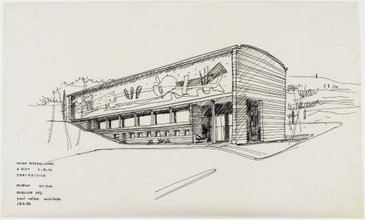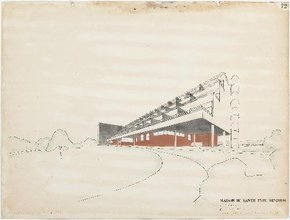Museum
Paul Nelson
29 Sep 2021 - 28 Feb 2022

The event is over

« Siège de la WGN Broadcasting » (détail), projet pour le concours avec Fernand Léger, Chicago, 1938 Perspective intérieure de l'auditorium © Paul Nelson © Centre Pompidou, MNAM-CCI/Georges Meguerditchian/Dist. RMN-GP
From September this year, the work of architect Paul Nelson will be showcased in the Galerie du Musée, a space dedicated to presenting the unique collection of the Musée national d'art moderne. Thanks to successive acquisitions (1993, 1995, 1998 and 2008) and the donation of archives by his wife, Maddeleine Nelson, and his sons, Ugo and Rory, the Centre Pompidou houses the bulk of the architect's collection.

« Siège de la WGN Broadcasting » (détail), projet pour le concours avec Fernand Léger, Chicago, 1938 Perspective intérieure de l'auditorium © Paul Nelson © Centre Pompidou, MNAM-CCI/Georges Meguerditchian/Dist. RMN-GP
Two original models, one of the surgery pavilion in Ismailia (1935) and another of the hospital in Saint-Lô (around 1950), as well as some sixty drawings from the architecture collection of the Musée national d’art moderne, nearly fifty archive photographs and ten or so documents from the Paul Nelson collection in the Kandinsky Library, offer an overview of his work and its singularity.
From the Palais de la découverte (1939) to Maison Badin (1954), the Cité hospitalière in Lille (1932) and the hospital in Arles (1974), not to mention the great Suspended House project, the exhibition documents the important theoretical aspect that underpinned Paul Nelson’s architectural thinking.
The exhibition includes two sculptures – one by Jean Arp and another by Alexander Calder – as well as two drawings by Jean Hélion and another two by Fernand Léger, to illustrate the friendship and intellectual and professional relationships between the architect and major modern artists.
Paul Nelson's life and personality make him an unusual figure. He was a major contributor to the modern movement in France and was close to certain artists with whom he shared research on the use of space. He became a specialist in hospital architecture, placing emphasis on the concept of "programme" in his numerous projects. Through his many trips to and from America and his stays in the States, he became a go-between, introducing French modern decorative art through a film and presenting American urban planning and housing techniques at an exhibition on reconstruction at the Grand Palais in 1946. He designed ambitious projects that his clients were unable to execute and developed his legendary idea of the Suspended House. His studies were compiled into a publication that has contributed to a fascination with his work on both sides of the Atlantic. The post-war reconstruction period was the opportunity for him to design his greatest work: the French-American Memorial Hospital in Saint-Lô. Still in use today, it is listed as a historic monument and is as striking as Le Corbusier's Housing Unit in Marseille, which was built around the same time.
In 1917, Nelson joined the US Army and fought as a pilot in the air force. He returned to France in 1920, married Francine Le Coeur and settled in Paris. He tried his hand at painting but soon studied architecture with Auguste Perret. In 1927 he graduated from the École Nationale Supérieure des Beaux-Arts in Paris. His first construction was a house in Paris for writer and fellow American Alden Brooks (1928-1930), and his second was a studio for his friend Georges Braque in Varengeville (1931). These were followed by other projects that were unfortunately never built. He designed hospital complexes for the Cité hospitalière in Lille (1932-1933) and the surgical clinic in Ismailia (1933-1935), which earned him international renown. Paul Nelson showed the same inventiveness in other projects such as the revolutionary Suspended House (1936-1938) and the remarkable Palais de la découverte in Paris (1937-1939). After the war, more of his designs were built including the hospitals in Saint-Lô (1946- 1955), Dinan (1963-1968) and Arles (1965-1974). Each project was the subject of in-depth research and an opportunity to work with his artist friends: Man Ray, Jean Hélion, Hans Arp, Juan Miró, Alexander Calder and Fernand Léger. The latter worked with Nelson to create coloured facades for the hospital in Saint-Lô and the architect would have dearly liked to design the museum dedicated to his work in Biot (1956).
The works housed in the collections of the Musée national d'art moderne have highlighted the connection between the architect and his artist friends, in exhibitions dedicated to them: Léger retrospectives (Centre Pompidou, 1997; Museum Ludwig de Cologne, 2016; Centre Pompidou-Metz, 2017) and the exhibition titled “Braque, Miró, Calder, Nelson. Varengeville, a workshop on a cliff” at the museum in Rouen in 2019. Similarly, Nelson's work is now rightfully included in publications and events on modern architecture including, most recently, the “UAM, a modern adventure” exhibition (Centre Pompidou, 2018). While the exhibitions in the rooms of the Musée national d'art moderne regularly offer the opportunity to discover certain aspects of his work, the exhibition in the Galerie du Musée will allow visitors to fully appreciate the wealth and originality that always guided his work.
When
11am - 9pm, every days except tuesdays
Booking strongly recommended







